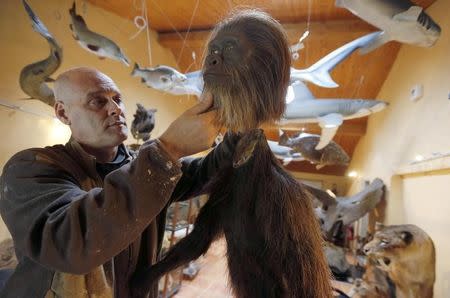The upper hand: study points to early tool use by human ancestors

By Will Dunham WASHINGTON (Reuters) - Human ancestors may have been capable of using tools much earlier than previously thought. Scientists said on Thursday an analysis of fossil hand bones of the species Australopithecus africanus that lived in southern Africa about 3 million to 2 million years ago indicated this human forerunner could use its hands in ways very much like modern people. This species, known for its mix of ape-like and human-like characteristics, possessed the uniquely human ability to have a power-squeeze grip as needed to wield a hammer and a forceful precision grip as used to turn a key, the study showed. "Forceful precision grips have been linked specifically to stone tool use and tool making, and so it is possible that Australopithecus africanus was using stone tools as well," said Tracy Kivell of Britain's University of Kent, who helped lead the study published in the journal Science with fellow University of Kent paleoanthropologist Matthew Skinner. This species appeared roughly a half million years before the first evidence of stone tools. The traditional view of scientists is that a species called Homo habilis that appeared about 2.4 million years ago was the pioneer in stone tool use in the human lineage. The scientists examined trabecular bone - the internal spongy structure of bones - in chimpanzees and other apes, modern people, and extinct species in the human lineage including Neanderthals as well as Australopithecus. Trabecular bone changes throughout an individual's lifetime in response to how the bone is being used. Because of this, trabecular bone reflects how an individual actually employed their joints and hands. The scientists found a distinctive asymmetric pattern in the distribution of trabecular bone in the modern human hand that reflects people's ability to forcefully oppose the thumb to the pads of the fingers for forceful precision grip. The same human-like pattern appeared not only in Neanderthals, known as proficient tool users, and early members of our own species, which first appeared some 200,000 years ago, but also in the much older Australopithecus africanus. This pattern was absent in chimpanzees, our closest genetic cousin whose last common ancestor with humans lived roughly 7 million years ago, and other apes. "This evidence suggests that species of Australopithecus were more human-like in their behavior than we previously thought and that we should concentrate our efforts on finding evidence for tools that they might have been using, whether made out of stone, wood or bone," Skinner said. (Reporting by Will Dunham; Editing by Sandra Maler)

